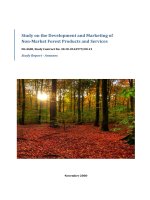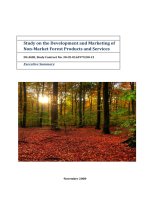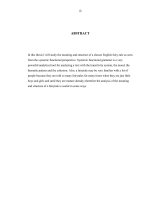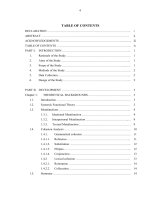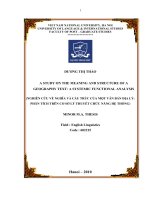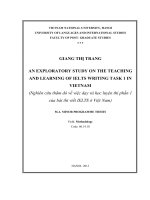Study on preparation procedure and standardization of recipe of Tikhur Burfi blended with cashew nut kernel
Bạn đang xem bản rút gọn của tài liệu. Xem và tải ngay bản đầy đủ của tài liệu tại đây (211.9 KB, 7 trang )
Int.J.Curr.Microbiol.App.Sci (2019) 8(4): 3040-3046
International Journal of Current Microbiology and Applied Sciences
ISSN: 2319-7706 Volume 8 Number 04 (2019)
Journal homepage:
Original Research Article
/>
Study on Preparation Procedure and Standardization of Recipe of Tikhur
Burfi blended with Cashew Nut Kernel
Nisha Chandel1, Deo Shankar Ram1, Mangal Singh Paikra1,
Chetna Banjare2 and Namrata Patel3
1
Department of Vegetable Science, 3Department of Soil Science, Indira Gandhi Krishi
Vishwavidyalaya, Raipur (C.G.), India
2
Krishi Vigyan Kendra Indira Gandhi Krishi Vishwavidyalaya, Raipur (C.G.), India
*Corresponding author
ABSTRACT
Keywords
Tikhur, Curcuma
angustifolia Roxb.,
Tikhur barfi,
Organoleptic score,
Hedonic scale rating,
Recipe
Article Info
Accepted:
20 March 2019
Available Online:
10 April 2019
An investigation was conducted at Shaheed Gundadhoor College of Agriculture and
Research Station, Kumhrawand, Jagdalpur, Bastar, Chhattisgarh in Horticultural
laboratory under AICRP on Tuber Crops. The experiment was undertaken during 2016 and
2017. The experiment was laid out in Completely Randomized Design in which 11
treatments tested in three replications for identification of best recipe for preparation of
blended tikhur Burfi. Tikhur Burfi was prepared in Horticulture laboratory for evaluation
of best recipe among 11 different treatments. The different recipe combination of tikhur
starch, cashew nut kernel sugar and water in 11 treatments were taken to standardize the
recipe. The results clearly indicated that the highest score was also awarded to recipe T10
for sweetness. Highest score of 8.31 was awarded by panel of 11 judges after organoleptic
taste of tikur Burfi to treatment T10=50 parts tikhur powder by weight+50 parts cashew nut
kernel. The hedonic scale rating of treatment T10 was awarded liked very much (LVM) and
liked slightly (LS) after 2 days interval of storage by Judges. The highest score was
awarded to treatment T 10 for its, flavour, fibrousness sweetness, texture and moisture
content and similarly T9 also recorded. Highest score was also awarded to treatment T 10 for
overall acceptability just after preparation and after 14 days storage by panel of judges. On
the basis of above findings it can be concluded that the treatment or recipe combination
T10=50 parts tikhur powder by weight+ 50 parts cashew nut kernel was best for the
preparation of blended tikhur Burfi.
Introduction
Tikhur (Curcuma angustifolia; family
Zingiberaceae) is a rhizomatous herb also
known as white turmeric or East Indian
Arrowroot. Its cultivation has now been
undertaken by the farmers of Bastar on a large
area. Tikhur is also found in central province,
Bihar, Maharashtra and Southern part of India.
In undivided Madhya Pradesh, it is widely
distributed in Bastar, Balaghat, Chhindwara,
Surguja, Bilaspur, Raipur and Mandla districts
(Kirtikar and Basu, 1918). Two types of tikhur
are found in the Bastar division; one with
3040
Int.J.Curr.Microbiol.App.Sci (2019) 8(4): 3040-3046
creamy white flowers and another having light
pink coloured flowers (Singh et al., 1999).
Tikhur rhizomes are used as appetizer
reducing burning sensations and stomach
pains, removal of stone from kidney, useful
for ulcer patient (Sharma, 2003) and rhizome
pulp is used for treatment of headache as well
as it gives cooling effect (Nag et al., 2006).
The starch of tikhur is used for the preparation
of many sweet meals and herbal dishes like
Halwa, Barfi, Jalebi etc. It is used specially
during fast (Vrata, Upwas). Farmers also
prepare herbal drink “Sarbat” through tikhur
starch during summer due to its cooling effect
(Singh and Palta, 2004). Better post harvest
management
and
diversification
for
production of value added products is one of
the dependable methods to make tikhur crop
lucrative to both farmers and entrepreneurs. In
future the tikhur Burfi may be best value
added herbal sweets of tikhur in all over India
and it may be famous sweets of Bastar.
Looking to the importance of the crop for
people of the Chhattisgarh an investigation on
the preparation procedure and standardization
of recipe for Tikhur Barfi and to find out the
best recipe for preparation of value added
product tikhur Burfi from starch of tikhur was
undertaken.
Experimental methods
The investigation was conducted at IGKV,
Shaheed Gundadhoor College of Agriculture
and
Research
Station,
Kumhrawand,
Jagdalpur,
Bastar,
Chhattisgarh
in
Horticultural laboratory. The experiment was
undertaken during 2016 and 2017. The
experiment was laid out in Completely
Random Design in which 11 treatments tested
in three replications for identification of best
recipe for preparation of tikhur Burfi. Best
starch quality genotype IGDMT-10-1 of tikhur
was selected as an experimental material and
starch of above genotype used for preparation
of tikhur Burfi. Tikhur Burfi was prepared in
Horticulture laboratory for evaluation of best
recipe among 16 different treatments. The
different recipe combination of tikhur starch,
sugar and water in 11 treatments were taken to
standardize the recipe. Tikhur starch powder
and cashew nut powder were weighed as per
treatment and quantities of sugar and water
was added as per standardized method of
tikhur burfi preparation. The level of burner
was always kept on medium flame and
continuously stirred through spoon. After 3-4
minutes of starch, cashew kernel, sugar and
water started coagulation. During this period
total soluble solids were measured by Digital
Refractometer. Then after 5-6 minutes the
solution was totally coagulated and put in
plate for setting down to give shape of burfi.
After setting and cooling of coagulated
material, prepared the pieces through knife to
give shape of tikhur burfi and it was now
ready for taking different observations and
Organopeptic Test.The tikhur Barfi were
evaluated in three replications by a panel of 11
judges consisting of staff and students of SG
College of Agriculture and Research Station,
Kumhrawand, Jagdalpur, Chhattisgarh for
organoleptic test. Scoring was done for
various characters based on 10 marks
headonic scale rating (Amerine et al., 1965).
The values given by each of the 11 judges
were then averaged for statistical analysis.
Experimental findings and analysis
The findings of the present study as well as
relevant discussion have been presented under
following heads: Estimation of total soluble
solids (TSS), final weight of prepared product
(Burfi), storability of Burfi and weight loss
during storage of tikhur Barfi (2016-17 and
2017-18): The tikhur Barfi prepared through
different recipes was subjected to analysis for
determination of total soluble solids (%), final
weight of prepared product (g), storability of
tikhur Barfi (days) and weight loss during
storage (%) and standardization of recipe for
3041
Int.J.Curr.Microbiol.App.Sci (2019) 8(4): 3040-3046
preparation of tikhur Barfi. The results
obtained are presented in the Table 1.
Final weight of prepared product (kg)
Final weight of prepared product was recorded
highest in treatment T0 (1.871kg) followed by
T1 (1.827kg). The lowest weight of prepared
product was recorded in treatment T10
(1.435kg) in the year 2016-17. Final weight of
prepared product was recorded maximum in
treatment T0 (1823.8kg) followed by T1
(1782.6 g) whereas, lowest was observed in
treatment T10 (1411.9 g) during the year 201718. As the tikhur content decreased and
cashew nut content increased in the final
product, the moisture content decreased in the
final product highest moisture content with
addition of tikhur powder was due to higher
level of starch, which facilitated the retention
of more moisture inside the dough during
burfi preparation.
Storability of tikhur Burfi (days)
Maximum storability of tikhur Burfi was
observed in treatment T10 and T9, during 201617 and 2017-18 i.e. 10 days and 9.4 days
respectively, which were significantly superior
to other treatments. The minimum storability
was observed in treatment T0 during the year
2016-17 and 2017-18 i.e. 4 days and 4.5 days
respectively.
Weight loss during storage (%)
Maximum weight loss per cent of tikhur Burfi
was observed in treatment T0 during 2016-17
and 2017-18 i.e. 18.96 and 18.88%
respectively, which were significantly superior
to other treatments. The minimum weight loss
per cent was observed in treatment T10 during
the year 2016-17.and 2017-18 (5.17 and
5.31%) respectively.
Table.1
Treatments
T0
T1
T2
T3
T4
T5
T6
T7
T8
T9
T10
Final
product
weight
1.871
1.827
1.783
1.740
1.696
1.653
1.609
1.566
1.522
1.479
1.435
2016-17
Storability
(days)
4
5
6
6
7
7
8
8
9
10
10
Weight loss
during
storage (%)
Treatments
18.96
18.64
5.88
13.04
13.23
12.50
10.60
9.78
13.33
7.40
5.17
T0
T1
T2
T3
T4
T5
T6
T7
T8
T9
T10
3042
2017-18
Final
Storability
product
weight
1823.8
1782.61
1741.4
1700.2
1659
1617.8
1576
1535.4
1494.2
1458.5
1411.9
4.5
5.8
6.2
6.5
7.2
7.4
7.8
7.6
8.2
9.3
9.4
Weight
loss
during
storage
18.88
18.72
6.62
12.78
13.12
12.42
11.31
9.82
13.15
7.52
5.31
Int.J.Curr.Microbiol.App.Sci (2019) 8(4): 3040-3046
Table.2 Effect of different levels of tikhur and cashew nut kernels on organoleptic score of tikhur burfi(2016-17)
Treatment
T0-100 parts Tikhur powder by
weight +0 parts Cashew nut kernel
T1-95 parts Tikhur powder
by
weight +5 parts Cashew nut kernel
T2-90 parts Tikhur powder
by
weight +10 parts Cashew nut kernel
T3-85 parts Tikhur powder
by
weight +15 parts Cashew nut kernel
T4-80 parts Tikhur powder
by
weight +20 parts Cashew nut kernel
T5-75 parts Tikhur powder
by
weight +25 parts Cashew nut kernel
T6-70 parts Tikhur powder
by
weight +30 parts Cashew nut kernel
T7-65 parts Tikhur powder
by
weight +35 parts Cashew nut kernel
T8-60 parts Tikhur powder
by
weight +40 parts Cashew nut kernel
T9-55 parts Tikhur powder
by
weight +45 parts Cashew nut kernel
T10-50parts Tikhur powder
by
weight +50 parts Cashew nut kernel
SEm
CD
CV
Appearances
Flavor Fibrousness Sweetness Texture
Moisture
Overall
Acceptability
8.30
7.82
7.67
7.57
8.47
5.32
7.53
5.17
4.88
3.83
5.26
4.23
3.92
4.55
4.43
4.92
4.28
5.23
4.92
3.90
4.61
6.02
4.90
5.47
6.28
5.28
4.92
5.48
5.88
5.94
5.57
6.62
6.02
6.02
6.01
6.10
5.91
6.28
7.28
6.59
6.38
6.42
6.23
7.04
6.92
7.58
6.92
6.32
6.84
6.98
7.08
6.98
7.54
7.52
6.94
7.17
7.48
7.02
8.12
8.24
8.02
6.92
7.63
8.62
7.98
8.24
8.56
8.32
8.08
8.30
8.19
8.02
8.57
9.28
8.68
8.62
8.56
0.19
0.55
4.80
0.17
0.50
4.55
0.03
0.09
0.81
0.12
0.04
0.99
0.04
0.11
0.94
0.04
0.11
1.03
0.04
0.12
1.03
3043
Int.J.Curr.Microbiol.App.Sci (2019) 8(4): 3040-3046
Table.3 Effect of different levels of tikhur and cashew nut kernel on organoleptic score of tikhur burfi (2017-18)
Treatment
T0-100 parts Tikhur powder by
weight +0 parts Cashew nut kernel
T1-95 parts Tikhur powder
by
weight +5 parts Cashew nut kernel
T2-90 parts Tikhur powder
by
weight +10 parts Cashew nut kernel
T3-85 parts Tikhur powder
by
weight +15 parts Cashew nut kernel
T4-80 parts Tikhur powder
by
weight +20 parts Cashew nut kernel
T5-75 parts Tikhur powder
by
weight +25 parts Cashew nut kernel
T6-70 parts Tikhur powder
by
weight +30 parts Cashew nut kernel
T7-65 parts Tikhur powder
by
weight +35 parts Cashew nut kernel
T8-60 parts Tikhur powder
by
weight +40 parts Cashew nut kernel
T9-55 parts Tikhur powder
by
weight +45 parts Cashew nut kernel
T10-50parts Tikhur powder
by
weight +50 parts Cashew nut kernel
SEm
CD
CV
Appearances
Flavor Fibrousness Sweetness Texture
Moisture
Overall
Acceptability
8.60
8.00
7.67
7.67
8.67
5.5
7.68
5.27
5.00
3.67
5.33
4.33
4.0
4.60
4.73
5.03
4.31
5.33
5.00
4.0
4.73
6.13
5.00
5.67
6.33
5.33
5.0
5.58
5.93
6.00
5.67
6.67
6.00
6.0
6.05
6.40
6.00
6.33
7.33
6.67
6.5
6.54
6.33
7.00
7.00
7.67
7.00
6.5
6.92
7.13
7.00
7.00
7.67
7.67
7.0
7.25
7.93
7.00
8.33
8.33
8.33
7.0
7.82
8.93
8.00
8.31
8.67
8.67
8.0
8.43
8.40
8.00
8.67
9.33
9.00
8.5
8.65
0.28
0.82
7.04
0.19
0.55
4.96
0.01
0.04
0.33
0.03
0.10
0.78
0.03
0.09
0.74
0.02
0.06
0.61
0.06
0.16
1..41
3044
Int.J.Curr.Microbiol.App.Sci (2019) 8(4): 3040-3046
Organoleptic score of tikhur Burfi
The mean score of different sensory
characteristics of blended burfi is presented in
Table 2. Organoleptic scores were judged by
panel of 11 judges and during 2016-17.
Scores for Appearance, Flavor, Fibrousness,
Sweetness, Texture, Moisture and Overall
acceptability
in
different
treatment
combinations were in the range of 5.17-8.62,
4.88-8.02, 3.83-8.57, 5.23-9.28, 4.23-8.68,
3.90-8.62 and 4.55-8.56, respectively.
The highest score of (8.62) was awarded to
treatment T9 for its appearance whereas,
lowest was (4.43) under T2.
In case of flavor, the highest organoleptic
score of (8.02) was observed under treatment
T10 for its flavour and lowest (4.88) for T1.
The treatment T10 had the highest
organoleptic score (8.57) for its fibrousness
and lowest was (3.83) for treatment T1.
For sweetness of tikhur burfi in treatment T10
recorded the highest score of (9.28) and
lowest (5.23) under treatment T2.
Highest score of (8.68) was awarded to
treatment T10 for its texture and lowest score
was (4.23) to treatment T1.
Highest score of (8.62) was awarded to
treatment T8 for its moisture content and
lowest score was (3.90) to treatment T2.
The overall acceptability recorded the highest
score of (8.56) under T10 the recipe i.e. T10-50
parts Tikhur powder by weight +50 parts
Cashew nut kernel while lowest score (4.55)
was recorded under the treatment T1 -95 parts
Tikhur powder by weight +5 parts Cashew
The mean score of different sensory
characteristics of blended burfi during 201718 is presented in Table 3.
Organoleptic scores were judged by panel of
11 judges and given in Table 3. Scores for
Appearance, Flavor, Fibrousness, Sweetness,
Texture, Moisture and Overall acceptability in
different treatment combinations were in the
range of 4.73-8.93, 5.00-8.00, 3.67-8.67,
5.33-9.33, 4.33-9.00, 4-8.50 and 4.60-8.65,
respectively.
The highest score of (8.93) was awarded to
treatment T9 for its appearance whereas,
lowest was (4.73) under T2.
In case of flavor, the highest organoleptic
score of (8.00) was observed under treatment
T10 for its flavour and lowest (5.00) for T1.
The treatment T10 had the highest
organoleptic score (8.67) for its fibrousness
and lowest was (3.67) for treatment T1.
For sweetness of tikhur burfi, treatment T10
recorded the highest score of (9.33) and
lowest (5.33) under treatment T2. Highest
score of (9.00) was awarded to treatment T10
for its texture and lowest score was (4.33) to
treatment T1. Highest score of (8.50) was
awarded to treatment T8 for its moisture
content and lowest score was (4.00) to
treatment T2.
The overall acceptability recorded the highest
score of (8.65) under T10 recipe i.e. 50parts
Tikhur powder by weight +50 parts Cashew
nut kernel while lowest score (4.60) was
recorded under the treatment T1.-95 parts
Tikhur powder by weight +5 parts Cashew nut
kernel The former treatment (T10) was liked
very much through hedonic scale rating as
compared to other treatment recipes.
Summary and conclusion is as follows:
Final weight of prepared product was
recorded highest in treatment T0 and lowest
was in T10. Weight loss during storage was
maximum in treatment T0 and minimum in
3045
Int.J.Curr.Microbiol.App.Sci (2019) 8(4): 3040-3046
treatment T10. Under organoleptic test of
tikhur Burfi the highest or organoleptic score
was awarded to recipe T10 for its flavour
fibrousness sweetness, texture and moisture.
The hedonic scale rating of treatment T10 was
awarded liked very much (LE) by panel of 11
Judges. The treatment T10 or recipe
combination T10= 50 parts of tikhur starch by
weight+ 50 parts cashew nut kernel has been
standardized for preparation of tikhur Burfi.
Treatment T10 awarded highest organoleptic
score by panel of 11 Judges and liked
extremely by judges through over all
organoleptic rating.
References
Amerine, M.A., Pangborn, R.M. and
Rocssler, E.B. (1965). Principles of
sensory evaluation of food. Academic
press, London, United Kingdom.
Anonymous (2005). Chhattisgarh Rajya
Laghu Vanopaj, Bajar Sarvekshan
Prativedan, CGMFPFED. pp 16, 17 &
42.
Kirtikar, K.R. and Basu, B.D. (1918). Pankaj
Oudhia’s Notes on Aegle marmelos (L.)
Corrêa. Indian Medicine Plant, 4 (2):
239–241.
Sharma, R. (2003). Medicinal plants of IndiaAn Encyclopedia. Daya Publishing
House, Delhi. pp 75.
Singh, J., Sharma, R.B. and Singh, R. (1999).
Improved
cultural
practices
for
cultivation of medicinal herb - Tikhur.
In Health care and development of
medicinal plants. pp. 319-324.
Singh, R. and Palta, A. (2004). Foods and
beverages consumed by AbujhmariasA primitive tribe of Bastar in
Chhattisgarh. Tribal Health
Bulletin. Regional Medical Research Centre
for Tribles (ICMR), Nagpur Road,
Jabalpur (M.P.). 10 (1&2): 33-40.
How to cite this article:
Nisha Chandel, Deo Shankar Ram, Mangal Singh Paikra, Chetna Banjare and Namrata Patel.
2019. Study on Preparation Procedure and Standardization of Recipe of Tikhur Burfi blended
with Cashew Nut Kernel. Int.J.Curr.Microbiol.App.Sci. 8(04): 3040-3046.
doi: />
3046
